Bayou Segnette State Park, Westwego, Louisiana (New Orleans)
Today’s agenda is a trip into New Orleans. According to the Park Ranger who checked us in, about 20 minutes away there’s a ferry that for only $2 will take you across the Mississippi River to town. She said it’s the best way to go. After having done it, we strongly agree!
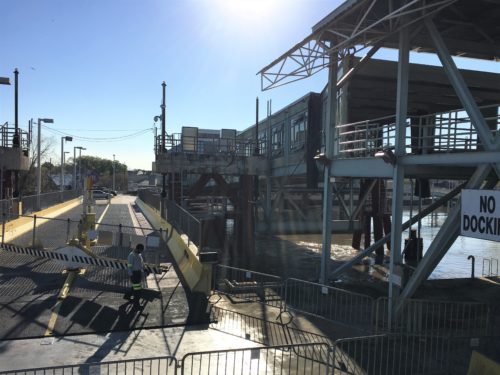
The ferry dock

As we wait to leave
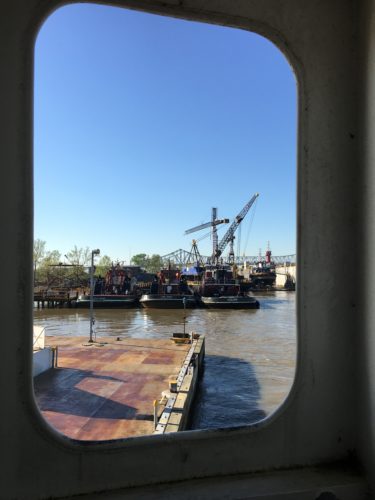

A bridge and a cargo ship

Our first glimpse of New Orleans! 9am
It was much more beautiful than the picture allows.
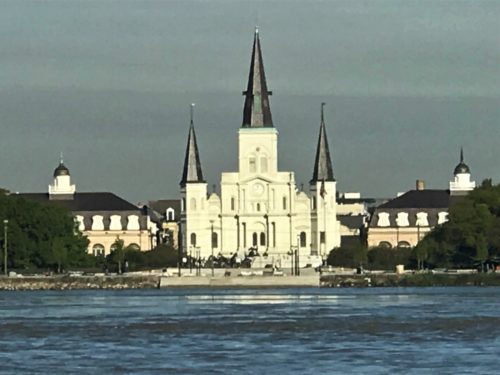
The St. Louis Cathedral
Can’t wait to see inside that!
Turns out, it wouldn’t be today. : (
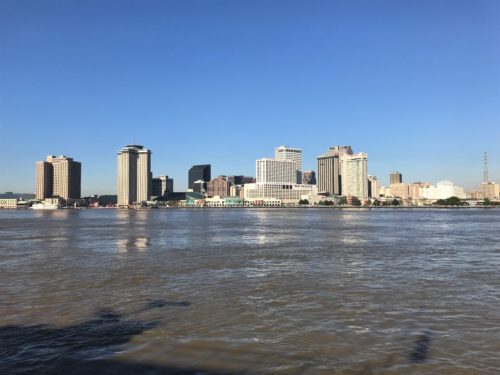

a tug pushing a barge
There was a lot of debris in this one section of the river. We didn’t see it anywhere else.
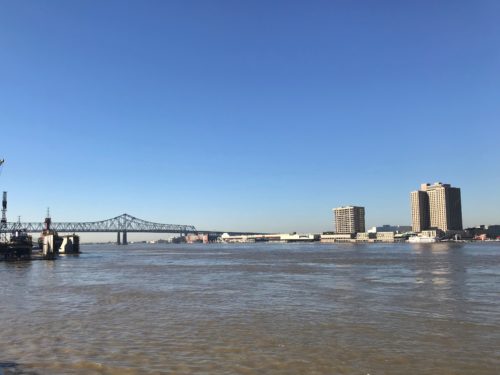
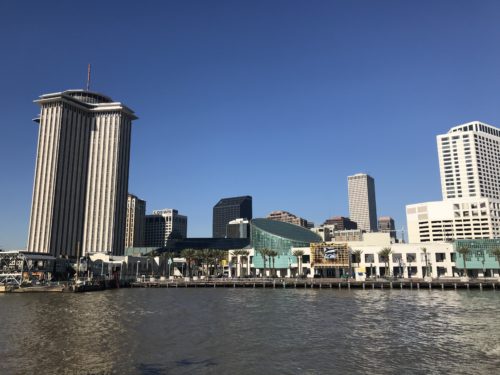

We’re nearing the dock now at the other side of the river.
We had almost 2 hours to kill before our NOLA Tour Guy walking history tour from 11-1 today, so we walked the river front, checked out Jackson Square and a bit of the French Quarter.
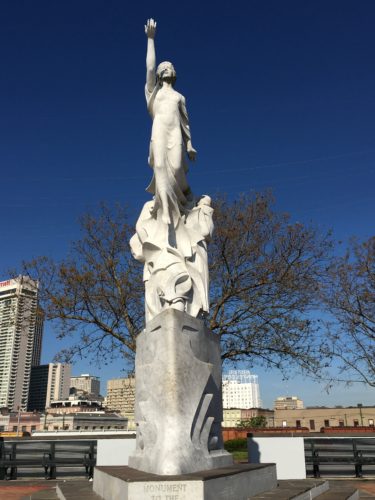
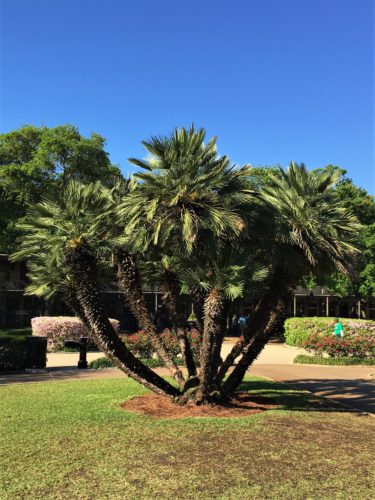
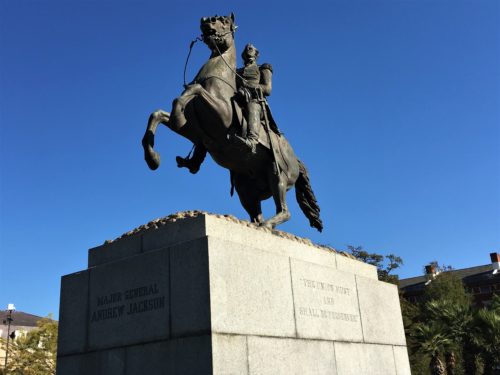
Andrew Jackson
We’ll learn more about why there’s a statue of him in our tour.
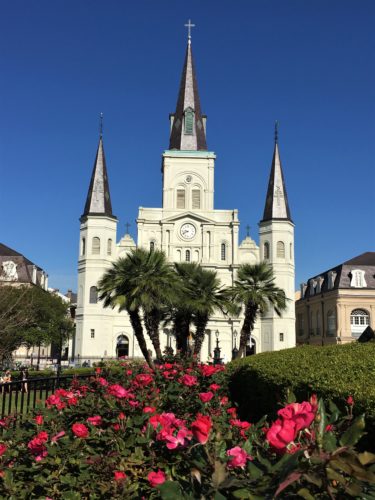
The St. Louis Cathedral
It’s so pretty, we took several pictures. : )
The buildings on either side are twins, and State museums.
One is called the Presbetyre, the other is the Cabildo. The Cabildo was also on our “must do” list, but it’s closed until April 21st for exhibition installation! Bummer!!
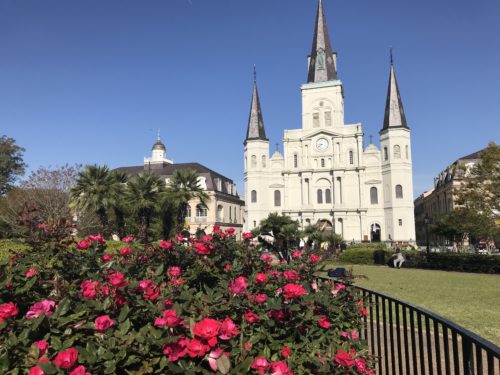
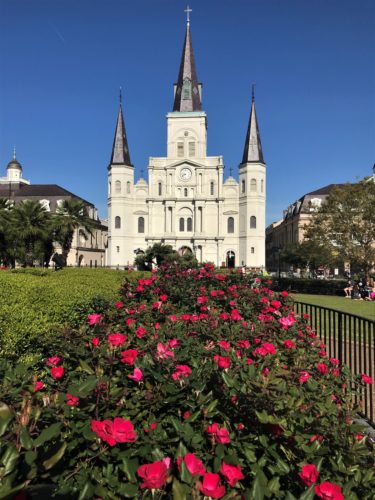


This is one of the two apartment buildings you’ll read about later.
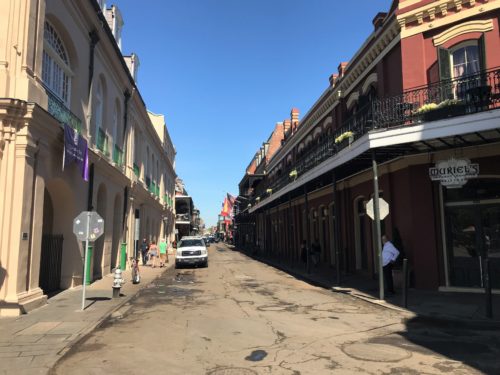
Tours abound here, and we chose a highly rated one that works a little differently. All other tours require money up front. This place offers the tours for free and asks that you pay your host what you think the tour is worth – or nothing at all. FYI – Eric was outstanding and we paid him well. 😊
We also walked over to check out Café du Monde which was highly recommended for their beignets. Beignets are a lot like donuts without the holes, and covered with a LOT of powdered sugar. Sounded like a great mid-morning snack before the tour! Well, when we arrived, we couldn’t get anywhere near the place as people were lined up out the building and down the street! It had to be at least a 2 hour wait!
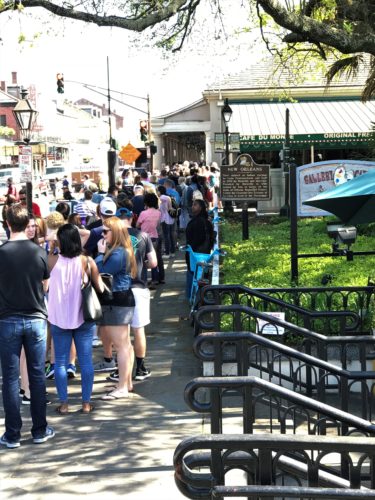
This is the line for Cafe du Monde!
Nothing could possibly be good enough to warrant that kind of wait!
Expecting to have to deal with growling stomachs before our tour was complete and we could grab a bite somewhere, we next found the Visitor Center. Turns out, this place has no loyalties to any of the businesses in the area, and among other things, steered us to Café Beignet. “They’re the same thing.” So off we went. We only waited in line about 15 minutes here. Oh my! They were wonderful! Fresh out of the fryer, covered in powder, they were amazing! A guy in line by our table offered to take our picture. We readily agreed! How nice! We couldn’t imagine that Café du Monde could possibly any better – and barely any wait!

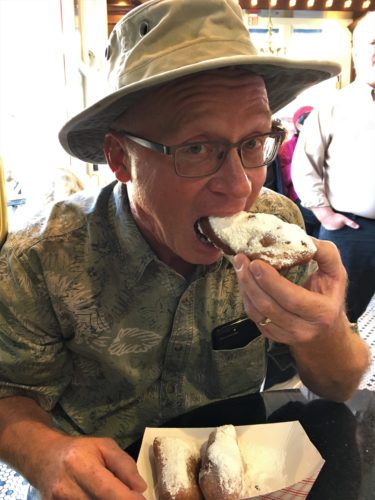
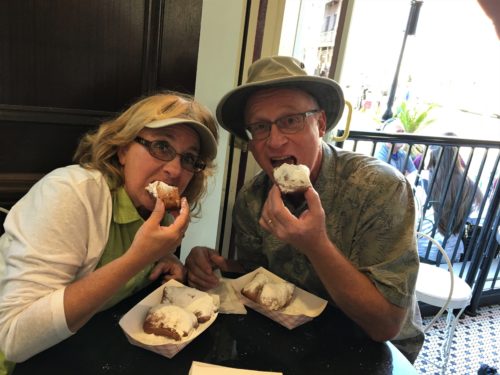
Shoulda closed our eyes in bliss!
After our delicious snack, we walked around a bit more.
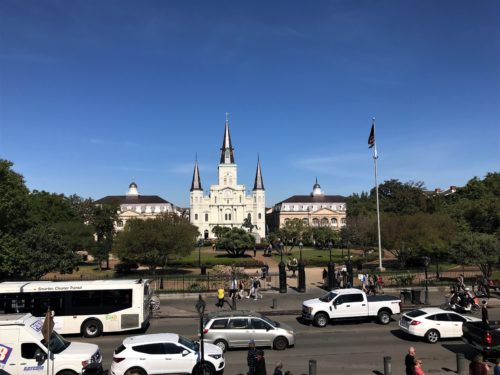
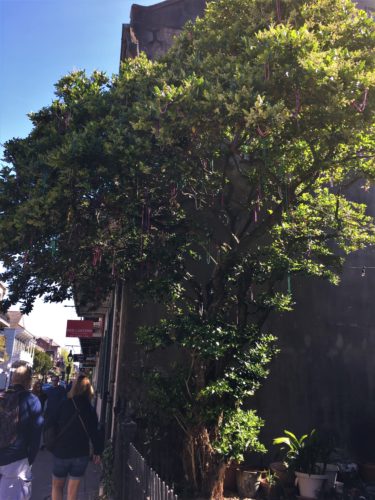
Lots of trees and power lines were covered in beads.
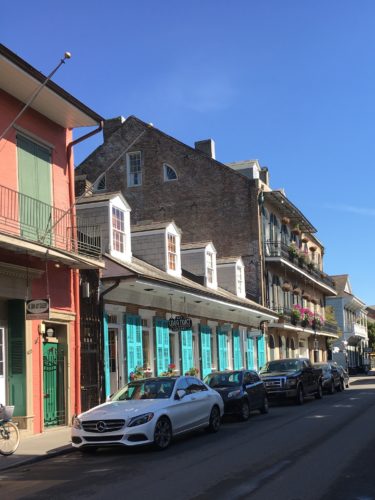
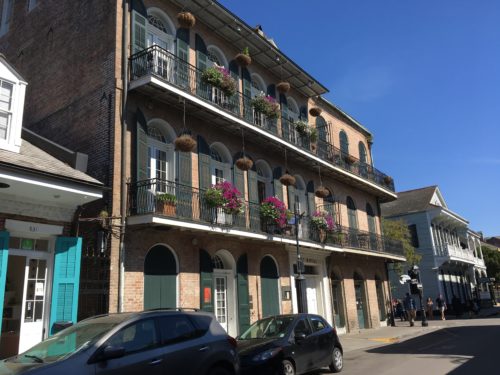

We didn’t have time to visit, but it looks interesting.
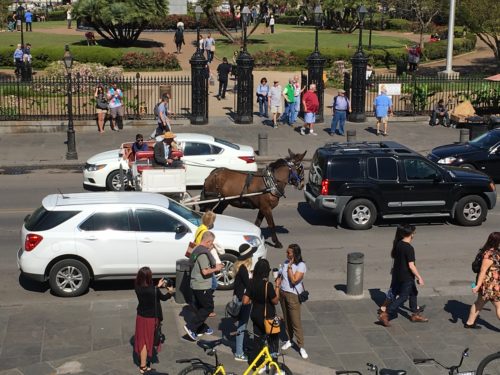
There are so many different things in the streets here!
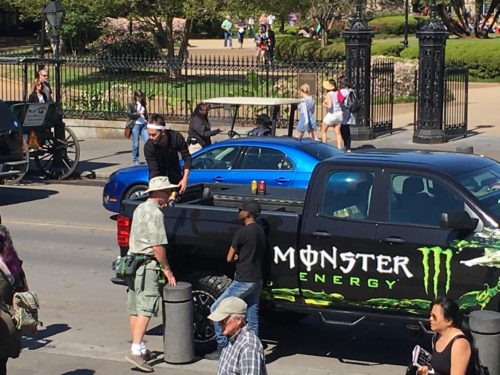
While we were waiting for tour time, we noticed that this guy was handing out free cans.
Blaine figured it was a good time to give it a try.
I didn’t care for it at all, he thought it was ok. : )
Unbeknownst to us, there was a big funeral in town today at the St. Louis Cathedral. High on our list of things to see, it’s obviously closed to tourists today. The funeral was for Tom Benson, owner of the Saints since 1985. He was 90 and died from the flu leaving a net worth of almost $3 billion (yes that Billion with a B!) There weren’t as many people hanging around outside in Jackson Park as I would have expected, but there were cameras set up all over, including where we were supposed to meet our guide.
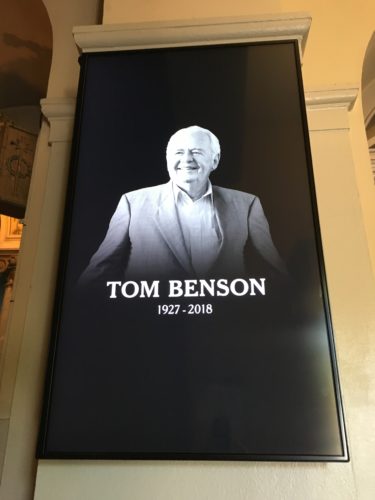
This was inside the Cathedral. We were able to take a quick peek inside later, but only took one quick picture because they were holding Mass.

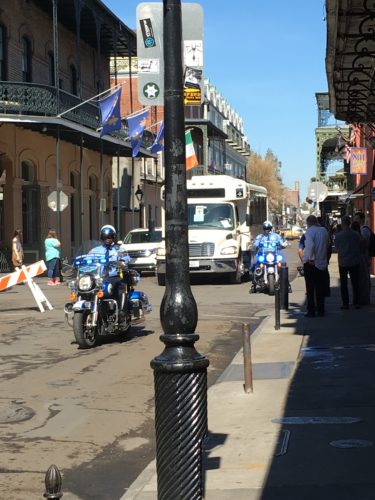
An escorted motorcade that most likely had the Saints players.

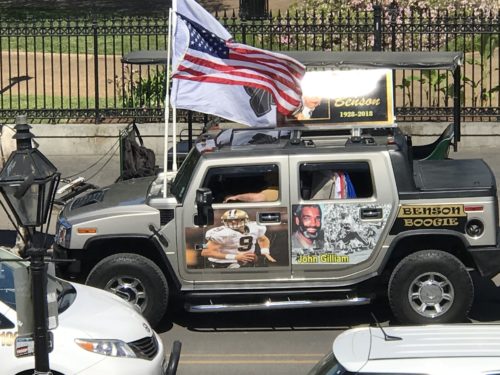
Just when it was time to start our tour, a guy with bagpipes climbed up on the cannon platform and started playing. Turns out, things like that are normal around here, but Eric couldn’t talk over that! We had to wait. (Note the cameras in the video, set up to capture part of the funeral)
He took us over to a corner to begin, but it was so noisy (street noise, bagpipe noise, construction noise, people talking noise . . . you get the picture), if we hadn’t been standing right in front of him, we wouldn’t have heard a thing – especially me.
It was a great tour with lots of walking and included information overload. When Blaine and I were talking about it over dinner, I asked what things he remembered. “Hi, my name’s Eric.” I laughed out loud!
Here’s a few things we remember: And yes, I looked up almost all numbers that go along with this list. I can remember what was said, but usually not numbers.
- This is the 300th anniversary of New Orleans – founded in 1718.

2. A woman, Micaela Leonarda Antonia Almonester y Rojas, Baroness de Pontalba (Absolutely I looked up her name!) was born in New Orleans in 1795 and given in an arranged marriage to her cousin (who’s father went on to become a French Baron) at age 15. Her father was also wealthy. She went off to France with her husband. Daddy died (he was 70 when she was born), leaving her the entire fortune and the title of wealthiest woman in New Orleans. Her father-in-law was angry that she wouldn’t give it up to her husband. He tried to kill her by shooting her 5 times with a pair of dueling pistols, then later that day shot himself and died. She lost a couple of fingers fending off bullets. 4 hit her in the chest, but she didn’t die. She tried to get a divorce, but never succeeded, but she did eventually succeed in getting a legal separation. But she did come back to New Orleans and did a bunch of stuff for the city, including building/renovating this square – two large buildings, each housing 16 four-story rental properties. Townhouses that have a commercial property on the bottom floor, the remaining floors are 3-story apartments. To this day, the apartments are in high demand and there is a 10-year waiting list. The Baroness died in Paris in 1874.
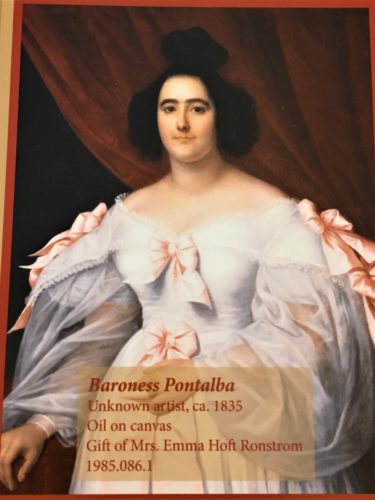
We actually ran across these pictures of her “tomorrow”.
If you look close, I think you’ll see the cover up of her missing finger(s). It looks like white fabric.

Here, the same hand is tucked down into her skirt.

This is one of the apartment buildings.
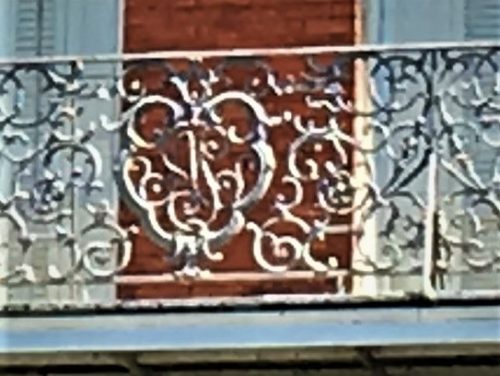
Supposedly, her initials (A & P, for her two last names) were custom designed into the ironwork.
I have trouble seeing it.
3. Andrew Jackson has a statue in the middle of the square named for him (Jackson Park). The statue was erected in 1856 because he saved New Orleans during the War of 1812. While the battle only lasted 25 minutes, the British tally was 700 dead, 1400 wounded and 500 prisoners (who had pretended to be dead and then got up after the battle was over and surrendered), for a total loss of 2,600 men. For the Americans, the tally was 7 dead and 6 wounded. The statue cost $30,000, weighs 20,000 pounds and was designed and sculpted by Clark Mills, who also did the “Freedom” statue on top of the Capitol Building in Washington, DC. There are actually 4 identical Jackson sculptures. The first was done for Washington, DC in 1853 and replicas were done in 1856 for New Orleans, 1880 for Nashville and 1987 (yes, that’s right!) for Jacksonville, Florida. It has historical significance because the one for Washington was the first bronze statue cast in the country and it’s also the first equestrian statue in the world to be balanced solely on the horse’s hind legs. The Baroness was one of the principle donors in the fundraising efforts.

Can you believe the detail on this? Right down to the veins on the horse’s legs!
4. Eric talked about slavery in New Orleans and how it was mostly the actual buying and selling of slaves that made money here, rather than the product they were bought to work. Tobacco was supposed to be here, but it didn’t grow well. Cotton wasn’t the biggest money-maker. Slavery was. There were two African-American women in our group and I found myself wondering what they thought of this part of the talk. He was very respectful and regretful, while stating facts as they were.
5. You can only visit the St. Louis Cemetery #1 with a licensed guide because of vandalism in 1960’s due to the influence of “Easy Rider” and the way Peter Fonda behaved at the cemetery in the film. This cemetery is owned by the Catholic Archdiocese so they can do that. The cemetery was created in 1789 because the townspeople were tired of the flooding in the area freeing the wood coffins and watching them float down the streets. And the reason they’re above ground is because of the wet ground. You can actually see some of them sinking. There were some interesting stories here, like the burial place of a legendary “voodoo queen”, Marie Laveau. And how real voodoo isn’t spooky and evil as depicted in Hollywood. That it’s a mix of herbal medicines and church tradition. There was also the tomb of Homer Plessy – a black man who could pass for white who, at the behest of a group pushing for equality, agreed to sit in the first-class section of a “white” train car, announced he was 1/8th black and was summarily arrested, forcing the courts to address the segregation issue. The Supreme Court ended up passing a “separate but equal” verdict in 1896, stating that segregation could still exist, but the facilities has to be equal quality. We also visited the tomb of Nicolas Cage – yes, the actual actor. And no, he’s not dead yet. It seems he purchased space, had a pyramid tomb built and gave the church enough money to hold it in perpetuity. That means they will always care for it. We got the impression that for some reason, the locals don’t care for Nick. I don’t know why. In addition, we learned that in most cases, many people are buried in the same tomb. They put you on the slab inside the tomb, wait a year and a day, take you out and put you in a cloth bag. Apparently, space is of a premium here and you won’t last long in the conditions around here, so this works for everyone.
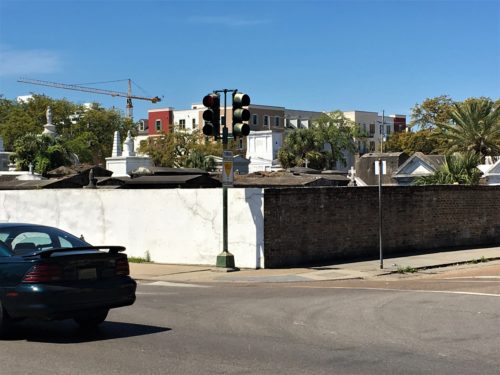
This cemetery sits right in the middle of town. Strange place for a cemetery . . .

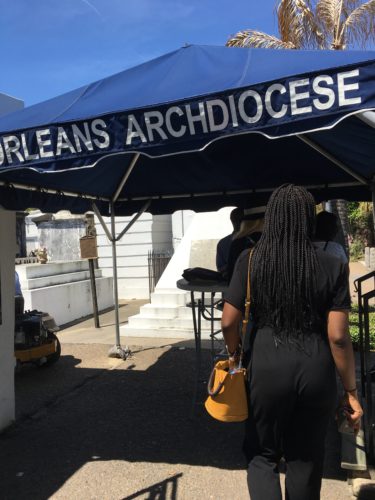
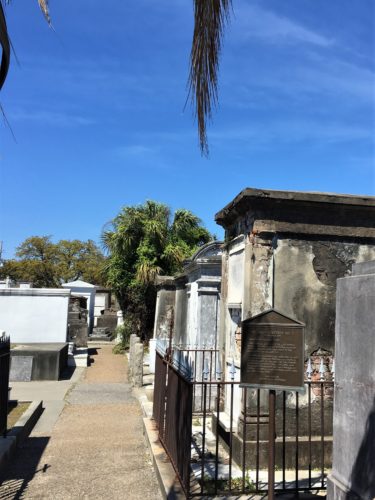
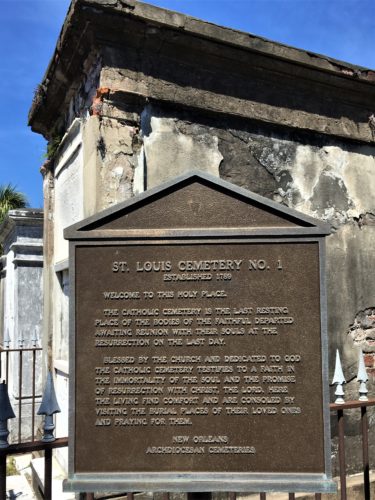

That’s Eric
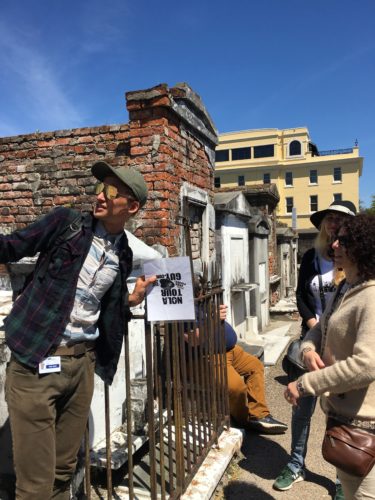
He’s telling us about how all the people are buried in this one tomb.
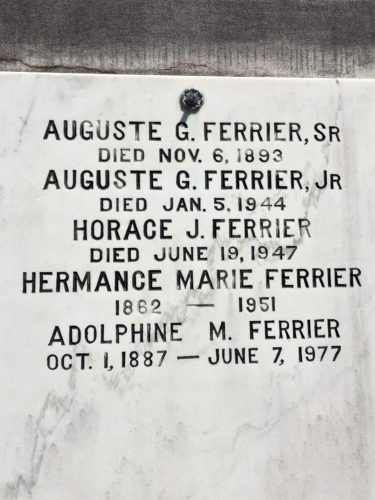
This is posted on the side of the same tomb
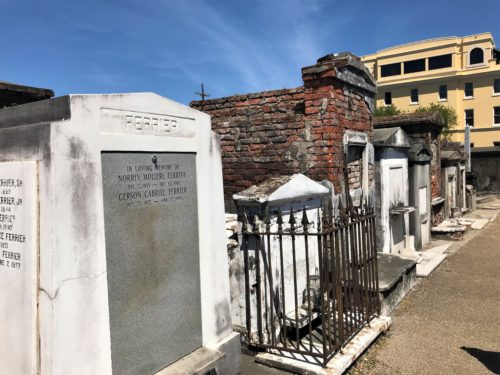
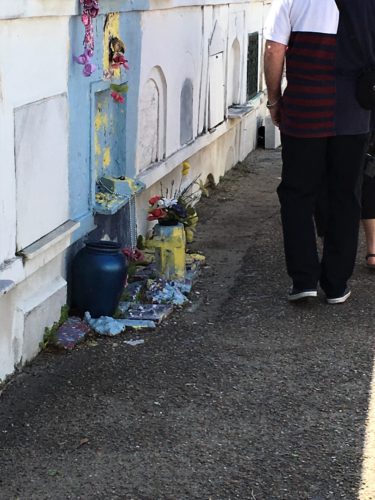
Look how much this has settled! The ones on the bottom are almost gone!

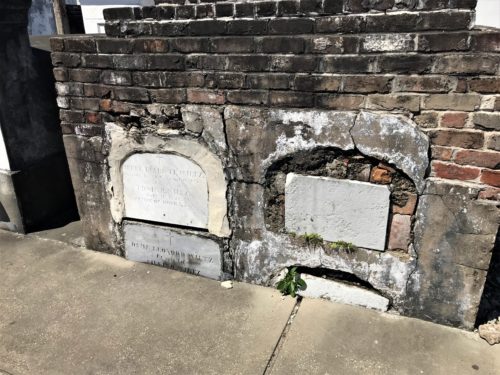
More sinking evidence
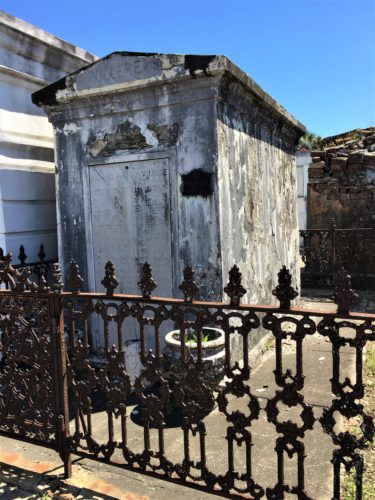

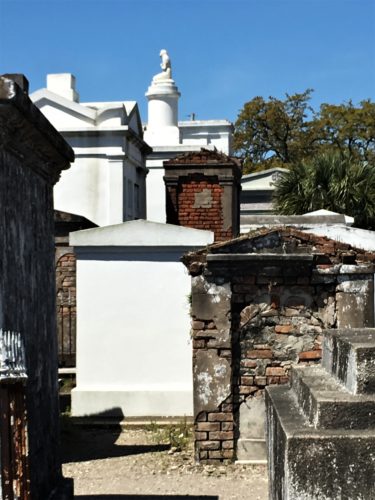
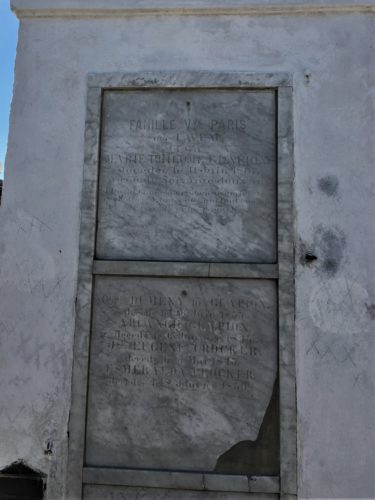
This is the tomb of Marie Laveau. See the Xs etched on the sides?
Many years ago, a bad tour guide started the rumor that if you wanted her to grant your wish, you had to draw an X, turn around three times, knock on the tomb and yell out your wish.
If she grants your wish, you have to return, circle your X and leave her an offering. I don’t see any circles . . .
Crazy people to believe this!
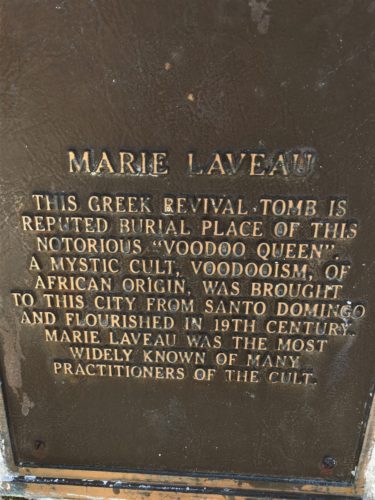
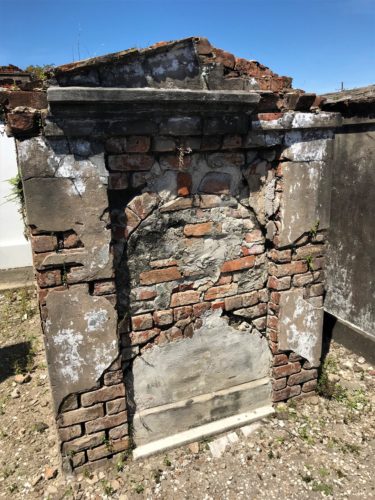
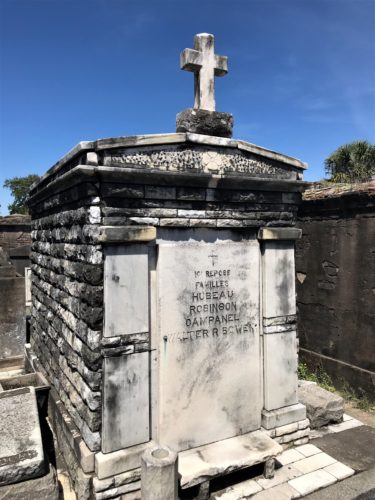

It just wouldn’t be a cemetery posting without a black and white!


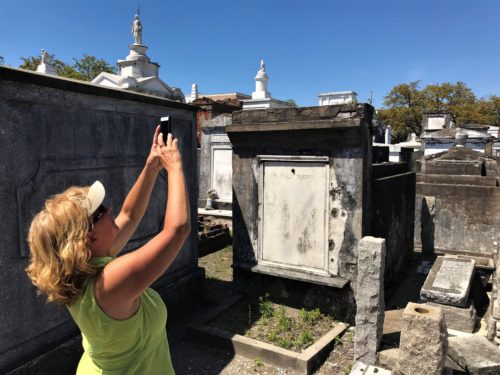
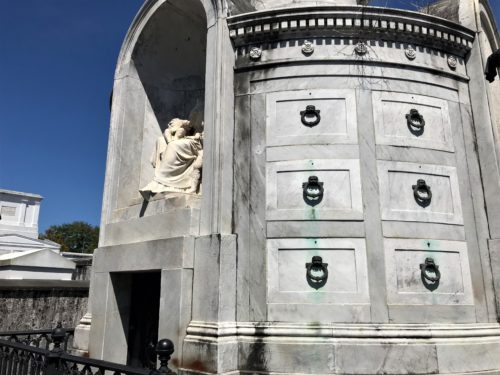
This is the mosoleum that Peter Fonda treated irrevenly in the movie, prompting others to come in and deface it.
The reason you can’t come in without a licensed guide.
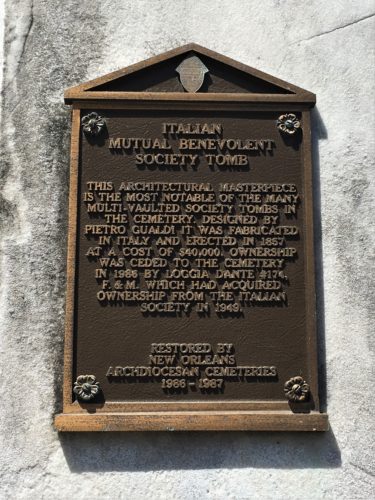
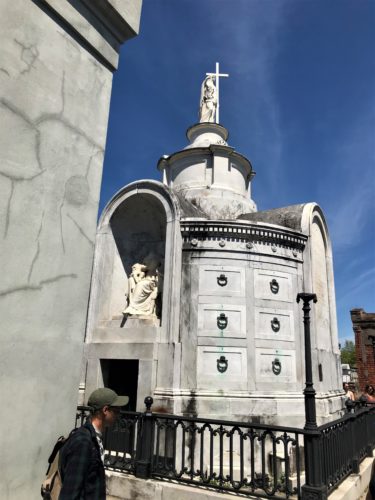


This one originally had a full face on it. As with many of them, the facing has fallen off and only a small piece remains.

Here’s what’s left of this one
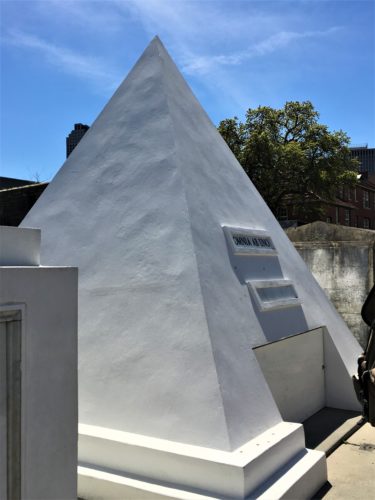
The tomb of Nicolas Cage.
It’s 9′ tall and takes up 4 spaces.
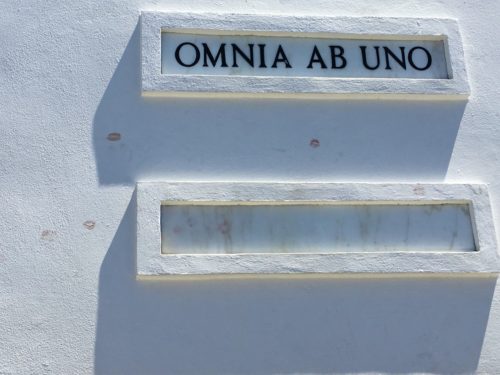
It means “Everything from One”
Another irritating issue for the Church – women keep kissing the tomb.
Someone’s gonna have to clean that up . . .

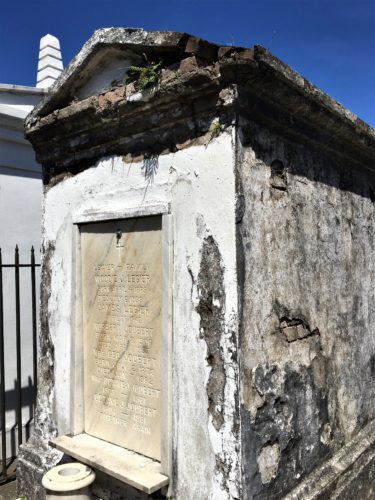
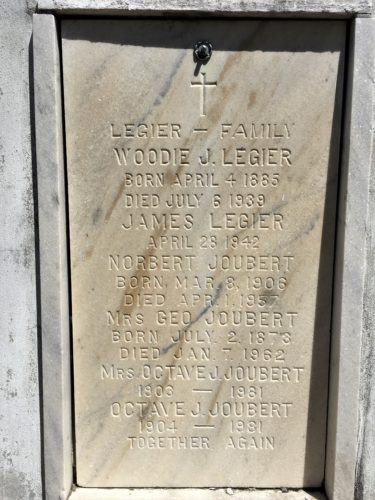

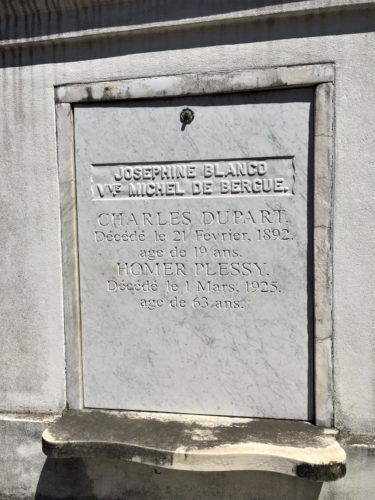
Homer Plessy’s resting place.

Look how only the center pedestal is sinking.
Interesting . . . .
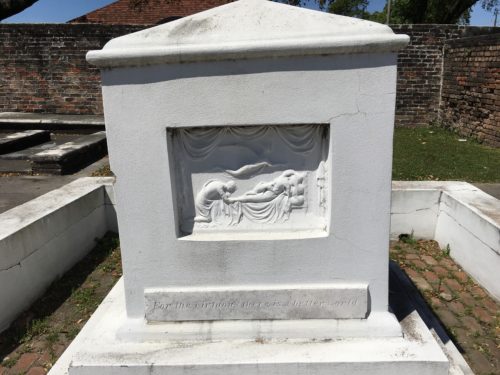

This was interesting.
A man got married twice. One wife is buried in the Catholic side. The other is in the Protestant side of the cemetery. Hmmm . . . .
Note that both father and son died of yellow fever 3 years apart.
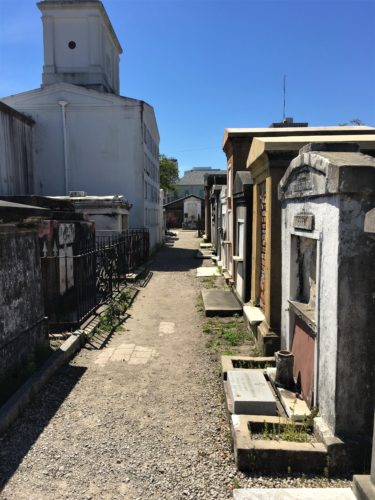
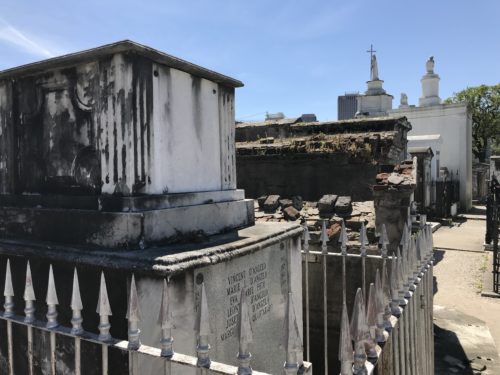


As we were leaving, Blaine was able to capture a better picture of these sunken tombs

This coffin is siting outside a Visitor Center across the street from the cemetery.

6. New Orleans was founded by France, ruled for 40 years by Spain and bought by the US (from Napoleon looking to earn some money for his war with England) in 1803 by the Louisiana Purchase. By the way, the LA Purchase, negotiated by President Thomas Jefferson and his envoys – Robert Livingston and James Madison – cost us just over $11 million and also assumed the claims of American citizens against France at close to $4 million. (I don’t know what those are. Presumably trade debt?) But the US gained 828,000 square miles of land, effectively doubling the size of the union, and protected the Mississippi River from being occupied by any other country – which was the main concern of Jefferson. So, during the span of 3 months (I think that’s the timeline given), Louisiana/New Orleans was ruled by England, Spain, France, and the United States. Eric told us that most people at the time didn’t even realize that. They just went about their daily lives unaware.
Here are some other places we visited on our tour:
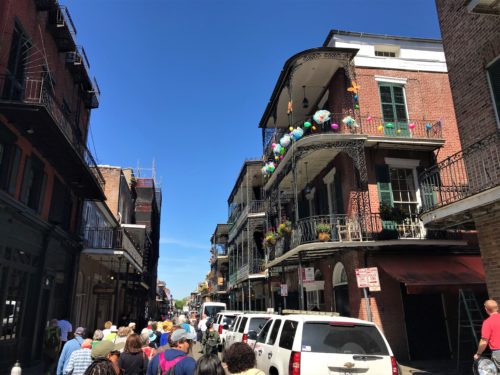

Because of the funeral, Eric took us to this “ally” behind the Cathedral to talk a bit.
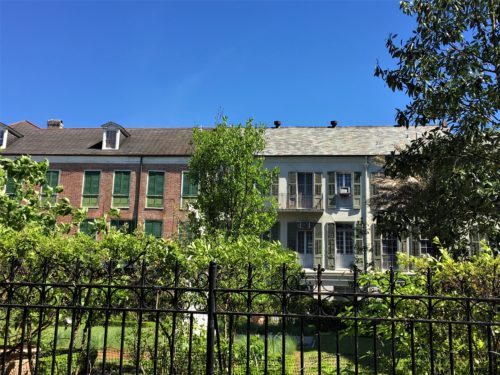
This was the view behind the church

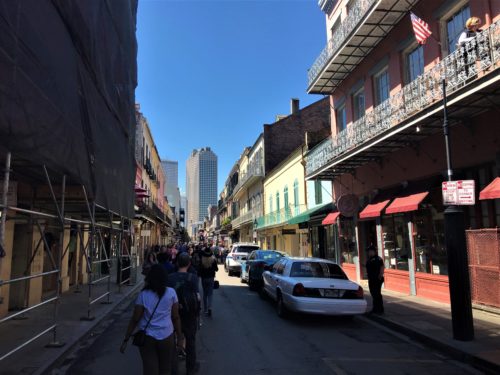


I remember that something was said about this building, but don’t remember what it was.
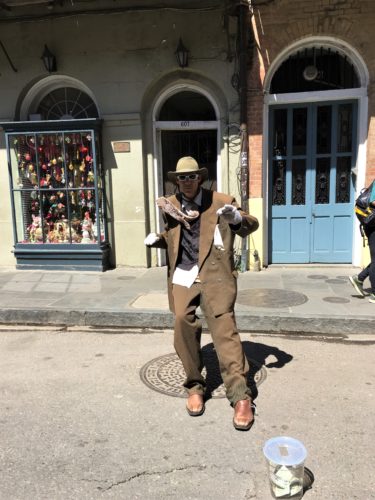
One of the street performers. And no, it wasn’t a bit windy. : )
They work for tips.
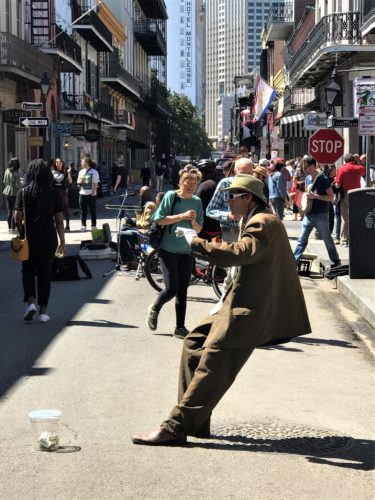
He never moved a muscle the entire time we were around!
How does he do that???
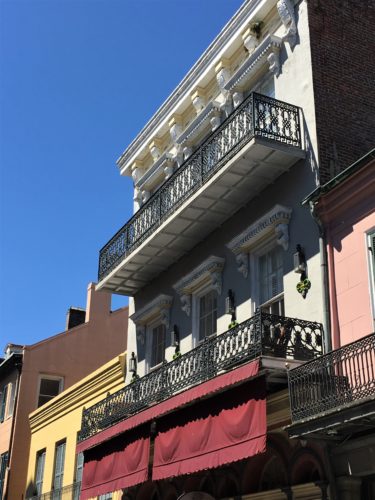

This is the oldest and largest coin store in New Orleans and, indeed, one of the oldest family owned businesses of any kind in the United States, Cohen and Sons opened for business in 1898

This is their storefront
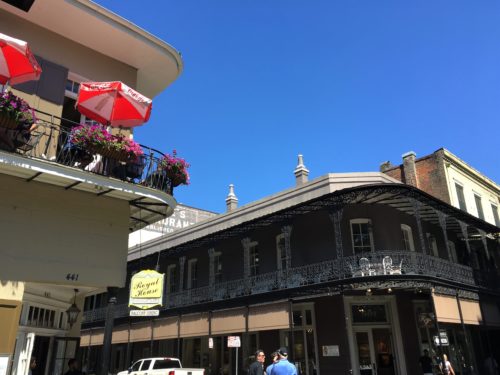
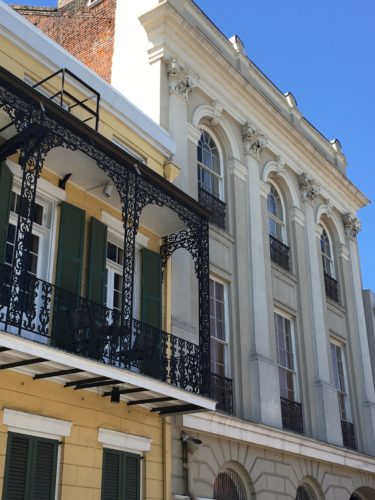
We walked all over the French Quarter, including Bourbon Street. They close a portion of Royal Street to traffic for a certain period during the day and street people set up to play music, etc. Later, in the evening, Bourbon Street closes and Royal opens back up.
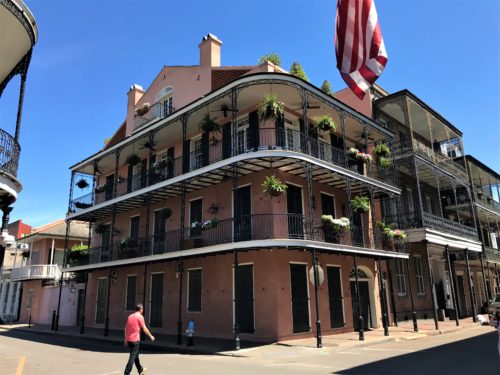
Here’s the nice picture Blaine took
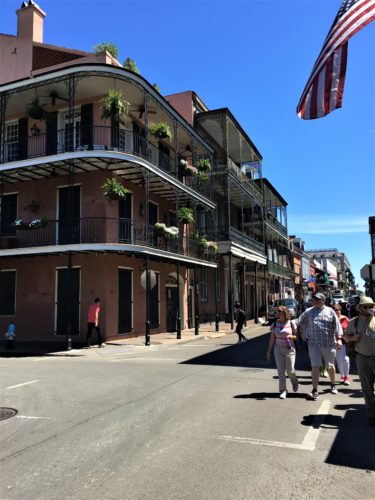
Here’s what the corner really looked like. : )
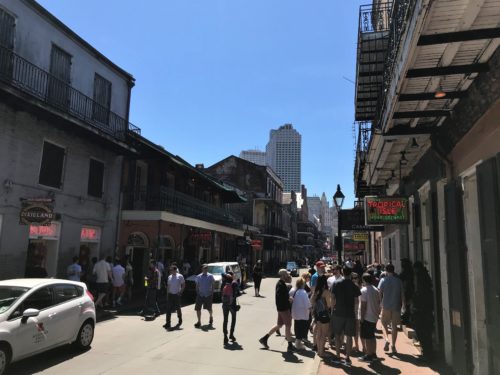

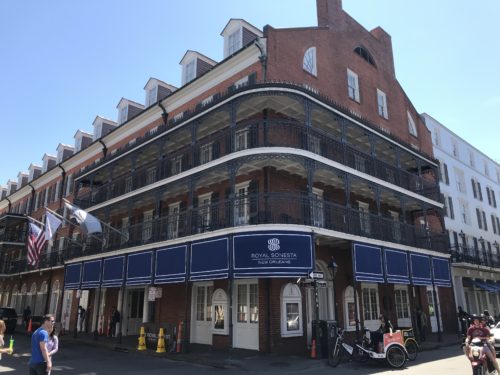


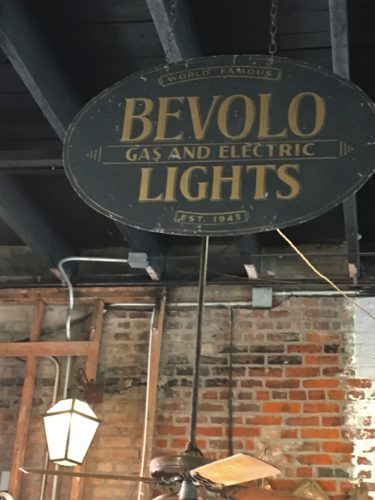
Blaine wanted to go check this out.

This guy was very conversational and Blaine really enjoyed his time in here.
Interesting work he does!

Even this courhouse has a history.
Court was held in the Cabildo, but eventually needed more room. They were going to tear down both the Cabildo and Presbytere and build new, but public outcry stopped them. Instead, they tore down an entire block of historic buildings and this marble structure was completed in 1910.
Just 48 years later, the building was abandoned for another location, until the 1990’s when they decided to move back here. Extensive renovations were needed by that time.
It’s currently in use once again.


This is a courtyard Eric told us to check out.
I can’t remember who’s it is, but as you can see, it’s pretty nice.
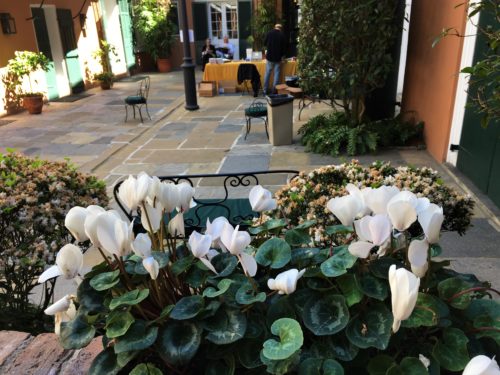

Another street artist.
We were surprised there were so many of these poetry writers!
We really should have tried one out, but I think we were just overwhelmed with culture shock.
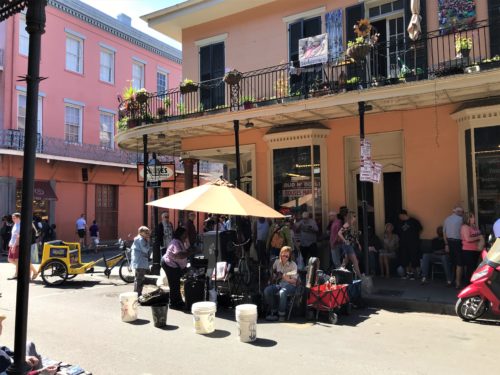
Another artist
If you watch the three videos that follow, you’ll see what just standing on the sidewalk was like.
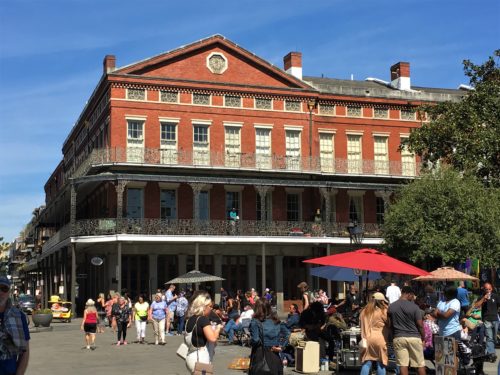
This area is in front of the Cathedral and between the two apartment buildings.
It was full of all kinds of street vendors – painters, musicians, magicians, fortune-tellers, etc.

This was on the outside of the Cathedral
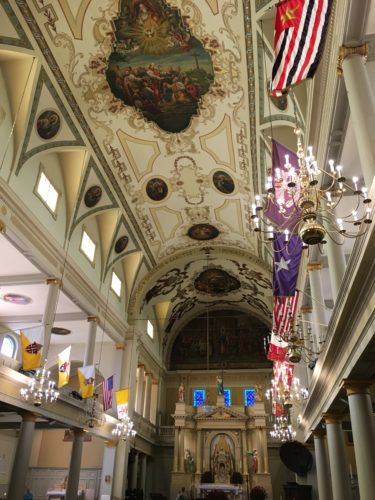
This is the best we could do today.
Hopefully, we’ll have a better opportunity another day.
A lot of places have open air seating areas with bands playing in them. Whenever we heard music we liked, we’d stop and listen for a bit. This particular place also had a fountain that doubled as a bird bath. 😊

This is one of those open air places. This one has famous jazz muscian statues all around.
At one o’clock in the afternoon, Bourbon street was interesting. At 5, when we were heading back to the ferry, it was even more interesting. We saw more drunk people, practically naked women, homeless people, loud men and women of all ages and races, than we’ve seen in our lifetime. We saw several families with young children walking down the street and wondered why in the world you’d bring your kids here – at least this street. Of course, they may not have realized how bad it would get. I’m sure as the evening goes on it will continue to progress. All I kept thinking was, There but for the grace of God, go I. It was sometimes quite sad, but never once did either of us feel unsafe.
We were able to watch a Second-line parade, although we discovered later that we missed the main parade for Mr. Benson due to our tour. Described to us as “A jazz funeral without a body”, the hosting group acquires a permit to parade down the street with police escort and hires a brass band to lead the way and garner attention from passersby. Those who follow them (walking) are called the second-line. Today’s participants were tossing beads. It was a small group and we had no idea who they were or why they were parading, but I was able to secure a set of beads from a young boy in the group. All I had to do was raise my hand, so just wipe that obscene thought from your mind at once!
We also saw a wedding party procession (sans band) as we were heading towards the ferry at the end of the day.
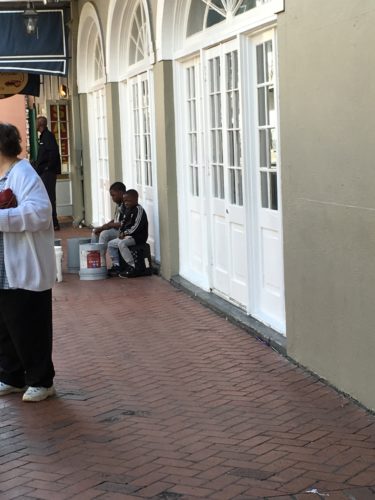
These boys were pounding out a rhythm.
More street workers for tips. We helped them out.
Unfortunately, you can’t really hear them in the video because of the band coming down the street.

A Second Line Parade

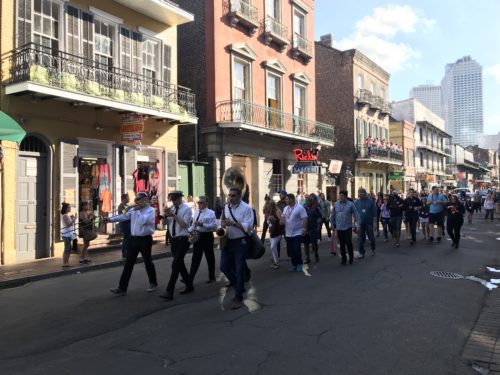
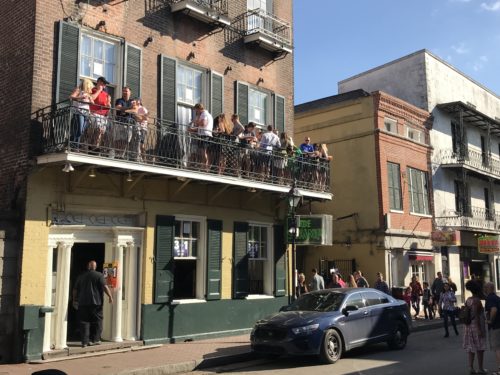
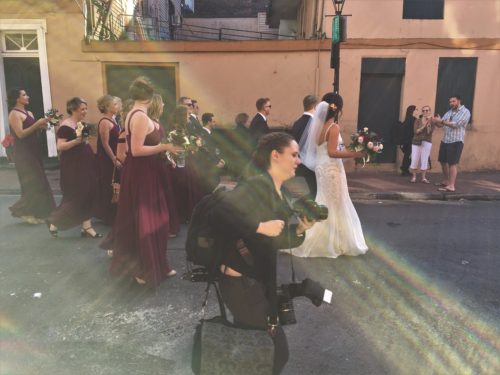

Dinnertime today was at 3pm at Evangeline’s. We ate in a quiet courtyard in perfect weather. We ordered Cajun nachos, jambalaya and alligator etouffee. The nachos were served on BBQ potato chips (that was different!) and brought with our dinner instead of an appetizer, but that was OK. It was good! Our dinners were good too, but not quite what we expected. My etouffee was more like a gumbo (in other words, soupy instead of creamy). I know the waiter forewarned me that it had lots of tomatoes and wanted to know if that was OK because theirs was different than other places. I just thought that meant it had extra tomatoes in it. That’s not what he meant. Different, meant it wasn’t in a cream sauce over Cajun rice. It was just the meat (lots of meat!), tomatoes (lots of tomatoes!) and a few diced green peppers and onions tossed in and cooked in wine – quite a bit of wine from the taste of it. But it was still good. Blaine’s jambalaya was also quite good, but he said he still likes mine better. 😊 It would have been nice to have some bread w/dinner, but by the time we were done, we were full without it!

Evangeline’s courtyard where we had dinner
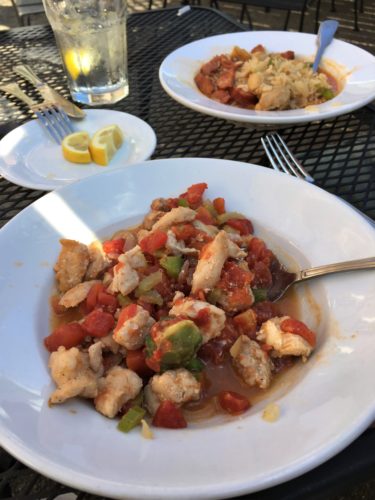
Alligator Etouffee

Jambalya

Cajun Nachos
We continued to walk around the French Quarter until we’d had enough for one day.
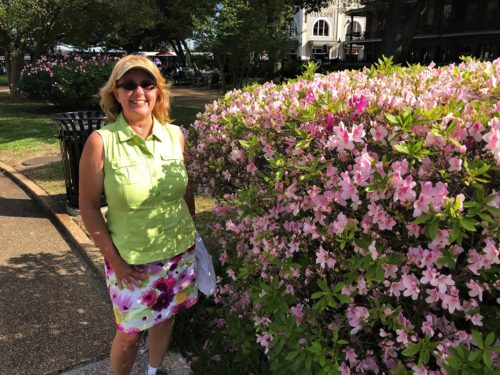
Blaine made me.
He said the azelea bush matched my clothes. : )
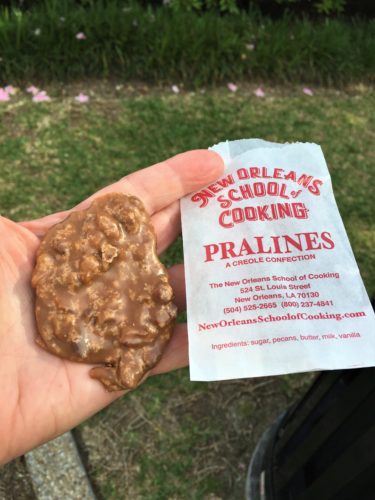
These were a dollar each.
Very sugary, but very good! We figured a cooking school was a good place to try them!
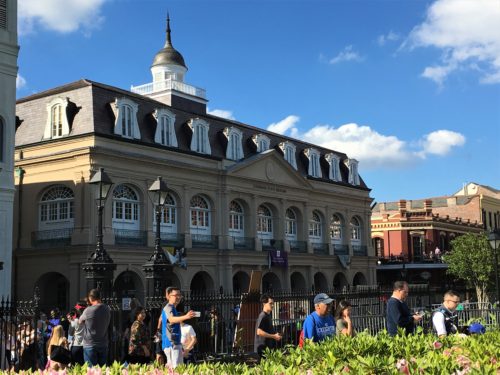
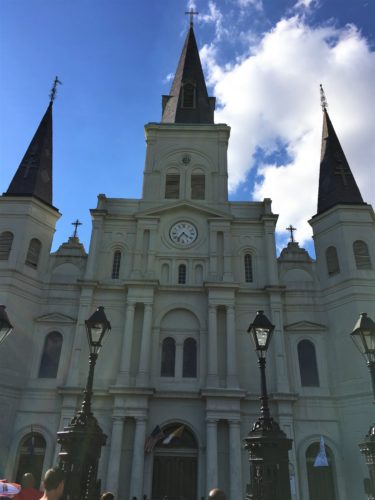
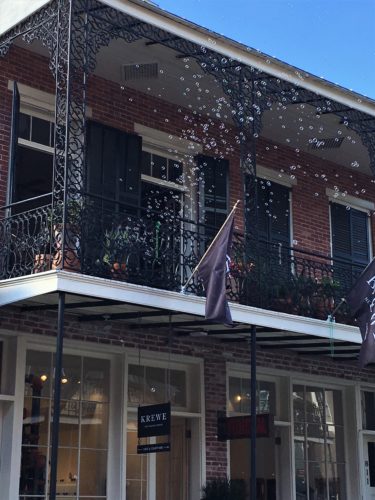
Bubbles!
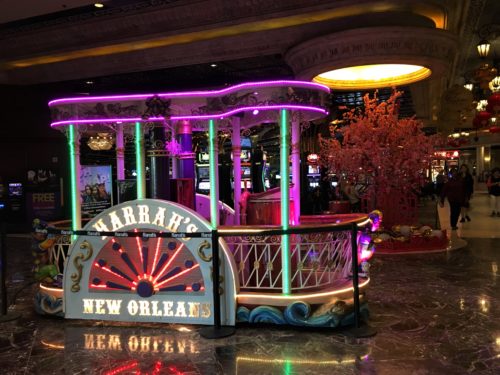
We cut through Harrah’s Casino
We were back on the ferry at 5:45, then the 20 minute drive home and rest!
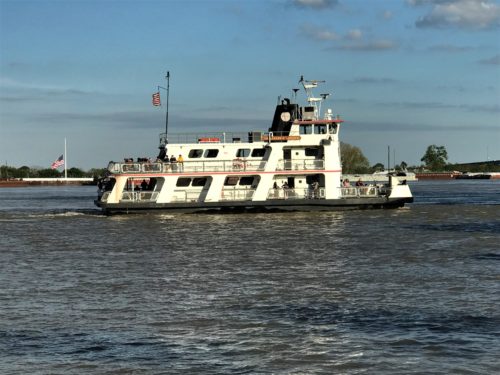
Here it comes!

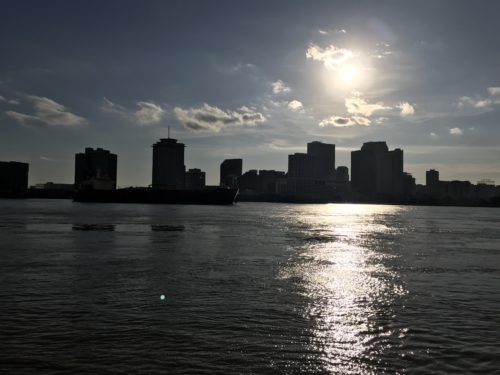
Tonight’s sunset
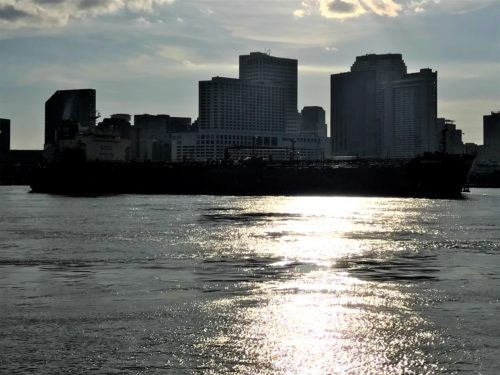
We need to plan what else we want to do in town, other than tomorrow’s 4 hour walking food/history tour! Yum!
TOTAL HIKING MILES: 7
Year To Date: 231
Daily Average: 2.85
